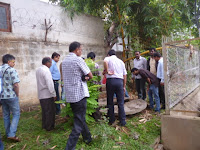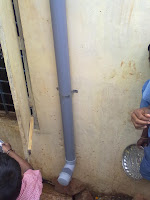Rainwater harvesting is becoming an
essential tool for citizens of Bangalore. It is not only a piece of
theory now, but has been practically implemented. With studies
revealing that Bangalore’s lakes are mostly now sewage lakes and
majority of them has just depleted has raised the concern for water
to a higher extent. Biome as rainwater club provides the knowledge
base for rainwater harvesting, grey water recycling as a part of
responsible water management initiative. Raising awareness among
people especially kids is also a part of this initiative.
This was a workshop with kids of
Adarsh Palm retreat located in Outer Ring Road conducted by Subhomita
Ghosh Roy from Biome Environmental Solutions on October 19,2013 from
4.30 to 6 PM. Shreya Vissamsetti a kid of Std. XII was the first one
who got interested in this. We made a Tippy Tap and a Rain gauge.
Tippy Tap is generally used for handwasing purpose to maintain
hygiene and also it saves water while handwasing compared to normal
tap water. Rain gauge is generally used for rainfall data recording
purpose. A week later a workshop was organized for the kids of Adarsh
Palm.
Kids were from 6-14 years. About 16
kids were present in the workshop.
Primarily it was information about
water issues, purpose and utility for water management and
conservation, rainwater harvesting, grey water recycling and what
Biome is doing in this regard. The kids were surprised to know
certain facts that were completely unknown to them. For example, they
were surprised to know that how deep we need to go for searching and
getting water from borewell or how rainwater harvesting is done or
the extent it can help us.Next it was the turn for them to make rain
gauges on their own. They were asked to get a bottle for the workshop
from which they made the gauges pretty easily with the markings on
it. They learned when and how this instrument is used. They also saw and used the
tippy tap that was made previously. Washing hand under it was a fun
experience for them.
The last part of this hour-long
workshop was the quiz. There were about 20-25 questions on water
awareness, water conservation, water issues in Bangalore and India,
rainwater harvesting, water recycling. At the end some gifts were
presented to all of them.
 |
| Rain Gauge |
 |
| Tippy Tap |
 |
| Workshop in Progress |
 |
| Quiz |





















































